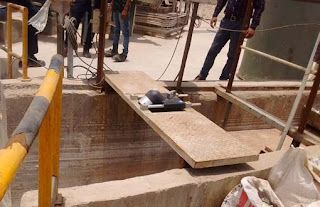 |
| LaserFlow Installation |
To reduce energy costs resulting from pumping, the effluent from the third production unit is sent to the treatment plant via gravity feed. The channel is 4.3 feet wide and 5.9 feet high. Therefore, the waste stream must be metered using an open channel method.
 |
| LaserFlow Installation (looking downward) |
Possibility 1 - Weir with level measurement. Problem: Weirs frequently clog with solids con-tent and require periodic cleaning to get accurate readings. This requires costly plant shutdowns.
Possibility 2 - Flume with level measurement. Problem: Building a flume to the dimensions of the channel is very expensive. It also requires a costly plant shutdown.
Possibility 3 - Area-velocity flow sensor (contact/in situ).
Problem: Debris and solid particles may cover the sensor and hinder velocity measurement.
Possibility 4 - Transit-time.
Problem: Solid particles reflect the ultrasonic signal from the transmitter, blocking it from the receiver. It also requires a costly plant shutdown.
Solution
 |
| Teledyne ISCO LaserFlow |
the site’s metering challenges. The above-water installation of this laser Doppler flow meter is not threatened by the list of potential issues above. Additionally, because it is installed above the water, the installation of the Laser-Flow did not require a plant shutdown.
The LaserFlow remotely measures the level and velocity of the flow in the influent channel. By using an ultrasonic level measurement, the sensor calculates a subsurface point at which to focus an optical laser. The Doppler frequency shift of the returned light is proportionate to the water’s velocity. The LaserFlow is able to measure velocities at up to fifteen points below the water’s surface. This minimizes the effects of turbulence and eliminates the need for manual profiling. By producing exceptionally accurate mean velocity readings and level measurements, the LaserFlow renders some of the most accurate area velocity measurement results in the industry. Additionally, due to the non-contact nature of the LaserFlow sensor, personnel safety is improved and operating costs are greatly reduced.
System Integration and Reporting
The LaserFlow, in conjunction with the Signature Flow Meter, collects level, velocity, and flow parameters that are outputted via 4-20 mA signals and received by the customer’s distributed control system (DCS). These parameters are used in conjunction with others by the DCS to provide comprehensive process control throughout the facility.
The Signature is unique in its ability to verify data integrity as four of its logged data types cannot be altered and are designed to alert the user to any trends or anomalies. This makes the LaserFlow and the Signature excellent choices for creating regulatory compliance reports.
For more information on the Teledyne ISCO LaserFlow, or to discuss your effluent flow challenge, contact Advance Instruments by calling (888) 388-6446 or by visiting https://advanceinstruments.com.